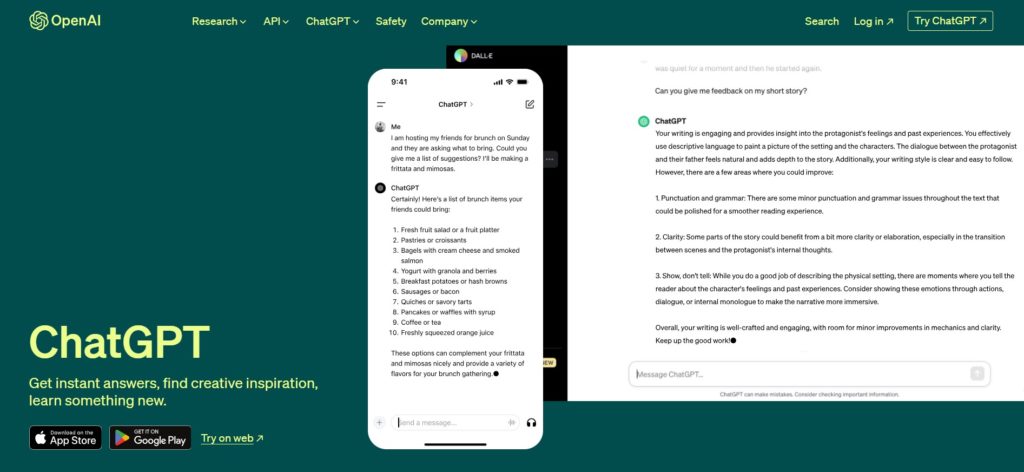If you’re relatively new to the AI field, you may be wondering, just what is ChatGPT?
ChatGPT is an advanced AI model developed by OpenAI that specializes in generating human-like responses in a conversational manner. As a sibling to InstructGPT, it’s designed to follow instructions in a given prompt and provide a detailed response, catering to various applications such as finding instant answers, creative inspiration, and learning new information.
This language model is part of OpenAI’s initiative to understand the strengths and weaknesses of AI-powered conversation systems. Users can interact with Chat-GPT for free during its research preview, allowing OpenAI to gather valuable feedback and optimize the model for improved performance in future iterations.
As technology evolves, Chat-GPT hopes to pave the way for innovative solutions and efficient communication in both personal and professional domains. Its unique capabilities present an exciting opportunity to explore the myriad possibilities of engaging AI-driven conversations, shaping the way humans and machines interact for years to come. So let’s take a closer look at this exciting new technology.
Table of Contents
Chat GPT Overview

History
ChatGPT, introduced by OpenAI on November 30, 2022, is an AI-based chatbot built on large language models. Designed to follow instructions and provide detailed responses to user prompts, this AI technology has seen valuable applications in various industries and across different use-cases, leading to significant interest in its further development.
As a sibling technology model to InstructGPT, it’s undergone various advancements to enhance its efficiency. Initially created as part of the GPT-3 family, it now employs next-generation GPT-4 models for improved performance, as noted by TechRadar.
Generations
Speaking of generations, let’s look at the differences between the two latest GPT models.
GPT-3: The third iteration in the Generative Pre-trained Transformer series, GPT-3, was a critical foundation for the development of Chat-GPT. This model showcased impressive capabilities in natural language understanding and generation, allowing users to interact with the AI to request specific information on various topics.
GPT-4: The newest generation, GPT-4, further refines the language model’s capacity to carry out tasks and engage in human-like conversations, all while providing accurate, context-aware responses. The latest Chat Completion API is the primary means of interacting with GPT-4 and offers exclusive access to this remarkable language model.
GPT Architecture
Transformer Models
Transformer models have revolutionized the field of natural language processing with their self-attention mechanisms and parallel computation capabilities. ChatGPT utilizes these features to effectively analyze and comprehend user prompts, and to generate coherent and contextually relevant responses1.
The underlying architecture allows ChatGPT to excel in tasks such as Natural Language Processing (NLP) and Natural Language Understanding (NLU)2.
The self-attention mechanism within a transformer model also enables it to strategically focus on different portions of an input sequence, giving more weight to important context and reducing the influence of unrelated information3. This capability has greatly contributed to the success of models like GPT-3 and GPT-4.
Recurrent Neural Networks
While the primary architecture behind ChatGPT is the transformer model, it’s important to understand the role of Recurrent Neural Networks (RNNs) in prior-generation language models too. RNNs were designed to handle sequential data by maintaining a hidden state in each time step, allowing the model to learn patterns in the input sequence.
However, RNNs do face limitations, including difficulties in parallelizing computations and handling long-range dependencies4.
Thankfully, the introduction of transformer models and self-attention mechanisms effectively addresses the limitations of RNNs. The parallel computation capabilities of transformers allow for faster model training, while their self-attention mechanisms tackle the issue of long-range dependencies3.
As a result, models like ChatGPT benefit from the advancements in AI research and deliver significant improvements in natural language tools and applications4.
Footnotes
Training and Fine-Tuning
Data Preparation
When working with ChatGPT, the first step involves data preparation. It’s crucial to provide quality training data for the model, formatted as a JSONL document. In this document, each line needs to include a prompt-completion pair as a training example. Users can take advantage of the CLI data preparation tool provided by OpenAI to convert their data into this file format efficiently.
Training data must be clear and diverse to ensure the model correctly understands the desired textual patterns. For instance, if creating an email response generator tailored to a specific business domain, it would be beneficial to use a varied set of examples pertinent to that domain.
Transfer Learning
Fine-tuning ChatGPT involves leveraging transfer learning, which allows the model to build upon its existing knowledge base and adapt to new tasks effectively. With transfer learning, the model is fine-tuned using the prepared dataset to achieve better performance in meeting specific needs.
Fine-tuning can be carried out using various tools, such as the OpenAI Node.js SDK or Python code, as demonstrated in this blog post. Regardless of the chosen method, fine-tuning involves adjusting model parameters to align with the target task.
Overall, following these steps for data preparation and transfer learning helps create a more specialized, efficient ChatGPT model tailored to specific tasks and domains.
Remember to keep the training data diverse and relevant while leveraging the powerful technique of transfer learning when fine-tuning the model. Also, for best results, keep the tone confident, knowledgeable, neutral, and clear while maintaining a third-person point of view as well.
Chat GPT Use Cases
Conversational AI
ChatGPT has been gaining popularity as an effective tool in the domain of Conversational AI. It’s capable of functioning as a virtual assistant, helping users with scheduling, reminders, and basic tasks too.
Additionally, it’s an excellent solution for customer support, as the AI can answer frequently asked questions and troubleshoot common problems in a seamless manner.
ChatGPT’s natural language processing capabilities also prove useful for businesses looking to provide real-time support through chatbots, such as in the banking industry.
Content Generation
Another powerful use case for ChatGPT is content generation. The AI model can create high-quality content for websites, blogs, and social media platforms in just a few seconds. This automation can save valuable time and resources for creators and marketers.
Besides generating text-based content, ChatGPT can be utilized in more specific scenarios, such as writing product descriptions, generating personalized email content, and even creating ad copy that follows brand guidelines.
By harnessing the potential of ChatGPT, businesses and individuals can enhance their efficiency and engage their audience in new and innovative ways.

Limitations and Challenges
Ethical Concerns
One of the primary concerns related to ChatGPT is its potential ethical ramifications. For instance, the AI may generate biased or inappropriate content due to biases already ingrained within the training data. This raises serious questions about accountability and the potential harmful impact of both spreading disinformation and reinforcing stereotypes.
Potential Misuse
The advanced capabilities of ChatGPT may also be misused by malicious actors to create deceptive content, manipulate public opinion, or engage in automated disinformation campaigns.
There is a real risk that ChatGPT-generated content might contribute to the spread of false information, making it difficult for users to distinguish between trustworthy sources and fabricated content.
Mitigation Strategies
To address these limitations and challenges, several mitigation strategies can be employed:
- Data debiasing: Improve the AI’s training data by identifying and removing biases, ensuring a more neutral and balanced foundation for content generation.
- User monitoring: Implement monitoring and reporting systems to detect and flag potentially harmful content generated by ChatGPT.
- Transparency: Make users aware of the limitations and risks associated with using ChatGPT, while promoting responsible usage at the same time.
- Regulation: Establish regulatory frameworks to govern the use of AI tools like ChatGPT and penalize those who use it for malicious purposes.
By adopting these mitigation strategies, stakeholders can help minimize the risks and drawbacks associated with ChatGPT, all while maximizing its potential benefits.
Mitigation is an extremely important piece to the AI puzzle here, since the key stakeholder, technically, is humanity itself. It will be very interesting to see how the future of ChatGPT, and AI in general, progresses in the coming years.
Future Perspectives
Research Directions
Speaking of the future, development of ChatGPT has paved the way for a myriad of potential research directions. Researchers are now focusing on improving the understanding capabilities and reducing biases in the outputs generated by such models.
Efforts are being made to enhance safety measures, especially in healthcare applications like clinical and translational medicine, ensuring the accurate and secure handling of sensitive information.
Additionally, experts aim to explore methods that can make large language models like ChatGPT more energy-efficient and sustainable as well.
Industry Impact
The implications of ChatGPT on various industries are vast. In the job market, large language models hold the potential to transform many jobs, automating mundane tasks and enabling professionals to focus on more complex and creative endeavors. Education, journalism, and customer service sectors are some of the key areas expected to benefit from the advent of advanced language models.
In the medical field specifically, ChatGPT is expected to revolutionize the way medical information is disseminated and processed, resulting in better decision-making and diagnostic capabilities for healthcare professionals. Moreover, industries such as law, finance, and entertainment may witness enhanced efficiency and novel applications, as ChatGPT continues to evolve.
As mentioned before, however, as ChatGPT progresses and other large language models emerge, it will be crucial to monitor the societal impacts of this technology, and also to regulate its implementation in an ethical and responsible manner. This will be paramount in ensuring the benefits offered by these models are widespread, contributing effectively to human progress.
Frequently Asked Questions
What are the main applications of ChatGPT?
ChatGPT has various applications in the enterprise and individual contexts, including automating tasks, augmenting human capabilities, and autonomously executing business and IT processes.
It’s part of the wider spectrum of AI and hyper-automation innovations, assisting in customer support, content generation, data analysis, and many more tasks. For more information, read this Gartner article on the subject.
How can I access ChatGPT?
To access ChatGPT, visit the OpenAI Help Center. The Help Center provides resources and guides for getting started with the AI model and managing accounts, as well as troubleshooting any issues.
Is there a free version of ChatGPT?
Yes, ChatGPT has a free version available for users. For more detailed information regarding the availability and features of the free version, please visit this Tom’s Guide’s article about ChatGPT.
What are the privacy features of ChatGPT?
Privacy is an important concern for ChatGPT users. The OpenAI Help Center offers resources and articles that address various aspects of data privacy, including chat history and model training. Here users can learn how to manage their data and utilize the available privacy features.
Is ChatGPT compatible with iPhone?
Yes, there is an iPhone app for ChatGPT.
What are some popular use cases for ChatGPT?
ChatGPT can tackle a wide range of tasks and queries, such as general knowledge, technology, historical events, scientific facts, and much more. For an insightful overview of the most frequent questions asked to ChatGPT, check out this Medium article.
- Amazon Email Phishing: How to Identify and Avoid Scams - May 11, 2025
- Malwarebytes vs McAfee: Decoding the Ultimate Antivirus Battle - May 11, 2025
- Best Antivirus for Windows 10: Expert Recommendations for 2023 - May 11, 2025










2 thoughts on “ChatGPT: Revolutionizing Conversational AI for the Modern World”